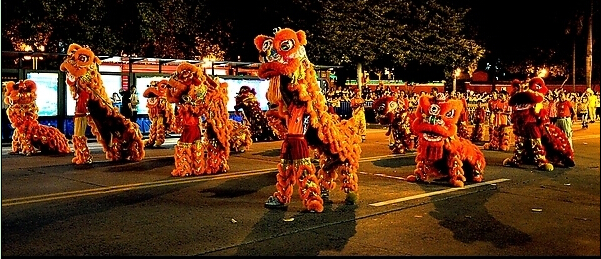Foshan shows true colors with annual fall parade

Foshan people are singing and dancing joyously to celebrate the Qiuse Parade which has evolved to a significant festival since the Ming and Qing dynasties.
Every year, residents of Foshan herald the coming of autumn with the annual Qiuse Parade, a festival celebrating the harvest. Qiuse literally translates to “fall colors” symbolizing the radiant scenery of autumn.
Taking place on a clear night either before or after Mid-Autumn Day, Qiuse is also called Qiuxiao, meaning “Mid-Autumn Eve,” or alternatively, it is known as Chuqiuse or Chuqiujing when it falls after Mid-Autumn Day. Over the years, the skills of performers in the parade have grown to such a great degree that participants now often compete for bragging rights, leading to a new name— the Qiuse Competition.
The parade’s many activities include horse riding, lantern lifting, playing the suona horn, drama, crafts, walking on stilts as well as dragon and lion dances.
The Qiuse Parade has a long history. It is generally believed that the Qiuse Parade originated from the Jin Dynasty and evolved from grass dragon dances performed by children to celebrate good harvests in autumn. But official records trace the parade’s origins to 1449 during the Ming Dynasty. According to local scholars, the festival is unique to Foshan, and it has been celebrated every year since it was first founded.
During the Ming and Qing dynasties, the commodity economy in Foshan flourished, and it was known at the time as one of China’s “Four Famous Towns.” The tradition thrived in these times of plenty, and over the period, the types of performances grew increasingly elaborate and diverse.
Adding to traditional activities, such as dramas and fire dragon dances, artisans began crafting symbolic imitations of products from farms and industry, starting a practice that would become an integral part of the festival in the years to come. These handmade vegetables, fruits, fish and desserts were made of various materials. Designed to fool the most discerning eye, these works of art represented the intricate skills and ingenuity of local craftsmen.
Slightly later, new traditions emerged, such as the dragonboat on land, dragon and lion dances, big-head Buddha figurines and Shifan gong and drum. These diverse practices represented the people’s sense of aesthetics as well as the spiritual and cultural life of the era.
The devastation brought by the Opium War had a severe impact on manufacturing and commerce in Foshan. Once symbolic of good fortune, the Qiuse Parade started to lose its glory as the city that gave birth to it fell into decline. But in the years that have passed since New China was founded, the parade has been restored to its former vitality and prosperity.
Li Xiaoyan is from Foshan Museum.
The Chinese version appeared in Chinese Social Sciences Today, No. 663, Oct. 31, 2014
Translated by Zhang Mengying
Revised by Justin Ward
